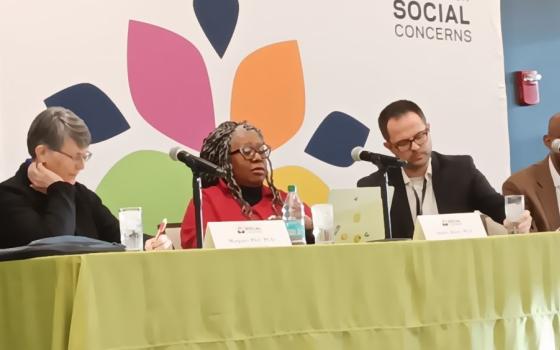
Over the past 20 years women religious in the United States have been writing a new chapter in the history of religious life -- the merger of small communities of aging members into larger communities with greater resources. The result has been renewed vibrancy for the sisters in both groups.
One such merger occurred on June 27, 2004, when 49 Vincentian Sisters of Charity gathered at their Bedford, Ohio, motherhouse to profess their vows as Sisters of Charity of Cincinnati. More than 150 of the Cincinnati congregation gathered to witness the two communities becoming one.
As a symbol of their new life together, water from Tinkers Creek on the Bedford property and the Ohio River in Cincinnati were poured into the vessel for the Sprinkling Rite of the day’s liturgy, celebrated by Cleveland Bishop Anthony Pilla.
The Vincentians “have revealed to the rest of us a path toward vibrancy,” Pilla said during his homily.
This path had taken the Vincentians on a decade-long journey of discernment and, for both communities, several more years of legal, emotional and spiritual preparation. The culminating merger was a “blessing bordering on the miraculous,” said Sr. Regina Kusnir, a member of the Vincentians’ leadership team during much of the process.
It was definitely “God’s gift to us,” added Sr. Margaret Mach, superior general of the Vincentians during much of their discernment.
Several other communities had already taken a similar journey. Three Dominican congregations from Fall River, Mass., and Newburgh and Ossining, N.Y., established a new congregation, the Dominican Sisters of Hope, in 1995. The Dominicans of Edmonds, Wash., joined the Adrian Dominicans in 2003. Other groups have followed suit, including two Ursuline communities in Illinois and Kansas that have merged with the Ursuline Sisters of Mount St. Joseph, Ky.
The common factor for these mergers or consolidations is the desire to live fully as women religious, faithful to their original charism, in the face of fewer vocations, aging members, and a diminished number of sisters available for key leadership roles.
The Vincentians, a community of the Cleveland diocese, first faced this reality in 1991. They started looking for the “broadest expression of what we are being called to,” said congregational superior Sr. Christine Rody, all the while “believing in faith that we would be led to do what we needed to do.”
The possibilities included returning to a community in Pennsylvania from which the Vincentians had separated in 1928, to affiliating with a larger community such as the Sisters of Charity. Another option was to do nothing and begin a dying process.
During a discernment retreat it became clear “there was too much energy in the group to focus on dying,” Rody said. “We wanted to focus on how we were being called to live.” At that time the community had 76 sisters, ranging in age from 41 to 86.
Over several years, the community’s leaders met with their sisters to hear their concerns and fears about forthcoming changes. Some worried about the fate of their motherhouse and the Light of Hearts Villa, a senior residence they cosponsored. Others feared the loss of community customs and the comfort of knowing every sister in the community. There were discussion groups and discernment retreats.
The Vincentian leadership team approached both the Pennsylvania community and the Cincinnati Sisters of Charity, organizing “getting to know you” sessions with both groups.
In 1999, the Vincentians decided to pursue a “fusion” model with the Pennsylvania community because of their shared history. After nearly two years of discussions, however, both communities agreed that reuniting wasn’t going to enhance either’s mission and they parted amicably.
The Vincentian leaders decided to approach the Cincinnati Charity sisters again about a merger.
Charity Sr. Mary Ellen Murphy, congregational president at the time, remembers the moment. “I realized this is real, has potential, is exciting and also scary. I knew it would require a lot of internal and external work.”
That work began immediately with numerous joint meetings about the financial, legal and canonical requirements of a merger as well as the implications for ministry and community life.
“We had no blueprint. We put one foot in front of the other and let God lead us,” said Mach, who later became director of the Evangelization Office in the Cleveland diocese.
“This wasn’t a business merger,” Murphy said, but rather the integration of two groups of dedicated women through a journey of faith.
Both groups of sisters trace their roots to St. Vincent de Paul and both embrace the virtues of humility, simplicity and charity. But the Cincinnati sisters had to learn more about the Vincentians’ link to St. Louise de Marillac and the Vincentian Sisters had to become more fully acquainted with St. Elizabeth Seton, from whose community the Sisters of Charity had come to Cincinnati.
 They also needed to get to know one another. They visited each other in their homes and places of ministry. They attended joint retreats and discussion groups. They reported their questions and concerns back to their respective community leaders.
They also needed to get to know one another. They visited each other in their homes and places of ministry. They attended joint retreats and discussion groups. They reported their questions and concerns back to their respective community leaders.
“There were no nonnegotiables,” Murphy said. “Everything had to be worked out. If there was an issue or concern, it was addressed.”
As part of the Sisters of Charity leadership team, Sr. Martha Walsh had voiced an initial hesitation.
“I worried that because the Bedford sisters were so much smaller that they would feel lost or overpowered,” she said. She was also concerned about how cultural differences would impact community life. The Bedford sisters were of Slavic background while the Sisters of Charity were primarily of German and Irish heritage.
Once she met the sisters, however, her uncertainties vanished. “I became convinced it would work and I wanted it to work.”
To help the Bedford sisters expand their emotional capacity for change, their leadership team devised some practical exercises. For example, one morning when the sisters arrived in the chapel, they saw that the chairs had been rearranged without prior notice or explanation. The new seating remained for two days. Then they were asked to talk about the change and how they felt about it.
Finally, on Jan. 11, 2003, in a secret, straw ballot, the Vincentian Sisters voted 47-1 for the merger, knowing this meant their Bedford community would officially be dissolved. Of the 55 sisters in the community, five were incapable of voting, one was on exclaustration and one chose to be absent, Rody said. When the official vote was taken, the vote was unanimous for the merger.
Two months later a straw vote among the Sisters of Charity showed 403 in favor and 16 against. Those opposing the merger, Murphy said, were “a small but vocal group” concerned about the financial implications of absorbing an aging group of sisters that included a high number in their 70s and 80s.
She watched with some apprehension during the final vote at the congregational chapter on March 21. Each of the 181 delegates was asked to vote by putting a green, yellow, or red card in a clear glass bowl. One by one the sisters placed green cards in the bowl; there was unanimous approval.
“Those who had resisted were able to let go of their agenda and vote for the merger, for the good of the whole,” Murphy said. “The Spirit was with us.”
Throughout the room the sisters’ voices resounded in song: “All Are Welcome.”
A phone call to Bedford communicated the good news. Later, the Vincentians were able to view a video of the voting.
“It was such a beautiful moment to hear them singing ‘All Are Welcome,’” said Mach, choking up as she recalled watching the video. “I knew this was a mutual act; both communities were doing this from our strengths.”
But the work of integration was far from over. While joint committees attended to canonical, fiscal and legal requirements, other sisters focused on spiritual and emotional melding.
Each Sister of Charity adopted at least five Bedford sisters as the focus of their daily prayer. They sent letters and e-mails and visited individually and in small groups.
“We were overwhelmed by their concern and care,” Rody said. “It was a big deal.” As a result, some of the Vincentian sisters’ remaining fear and timidity evaporated.
One Vincentian sister, Elisabeth Ann Rechka (now deceased), took the Charity sisters’ directory and memorized the name and photo of every member. Another drove frequently from Bedford to Cincinnati to spend Sunday afternoons with the sisters.
When the moment arrived for the official merger on that June day in 2004, the Bedford sisters spent the morning in a closure ritual with a “Blessing of Memories.” They carried community symbols into their chapel for reflection and prayer, celebrating their life together and grieving all they were relinquishing. They placed their community banner, their constitutions and their seal in front of the altar.
The public vow ceremony at which each Vincentian sister became a sister of Charity took place that afternoon. A sister of Charity had accompanied each of the elderly Bedford sisters to the outdoor Shrine of Our Lady of Levocha where the ceremony took place.
“We were so surprised by the one-to-one companionship,” Kusnir said. “This attention to such a tiny detail showed us again the quality of the community we were joining.”
Seven years later, the sisters concur that the merger has worked. The 392-member congregation and its varied ministries are flourishing.
Seventeen of the 49 Vincentians who participated in the merger now live in Cincinnati. Another 19 have died. The remaining 13 continue their ministries in the Cleveland/Bedford area.
Each year the Sisters of Charity have special feast day observances for both Louise de Marillac and Elizabeth Seton. Their annual jubilee celebration honors the vow anniversaries of both groups. Light of Hearts Villa is administered as a 50-50 partnership between the Cincinnati Sisters of Charity and the Sisters of Charity of the St. Augustine Health System.
Another sign of the full integration occurred in April when Rody, a canon lawyer, was elected as one of five members of the new Leadership Council.
In the end, the sisters were like their foremothers who had set off in small groups to form new religious communities in the 19th and 20th centuries. Now in the 21st century they have taken the necessary steps to preserve their religious calling while creating something new.
[Monica Clark is an NCR West Coast correspondent. Her e-mail address is mclark@ncronline.org.]
Stories in this series
|



